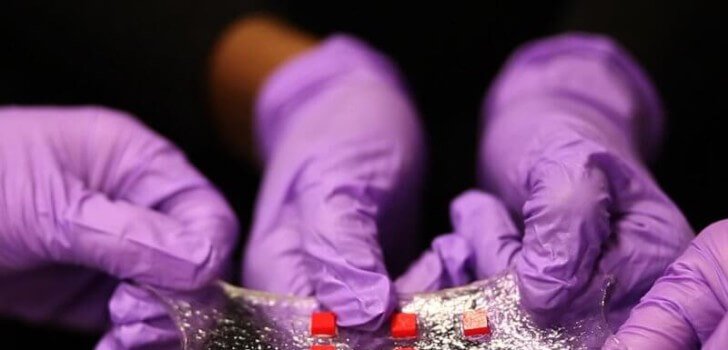There could soon be a major change coming to bandages, as a group of mechanical engineers from MIT have developed an innovative new “smart” bandage that can monitor wounds and even administer drugs. The bandage is made from a stretchy and rubbery hydrogel, and it features a system of electronics and drug reservoirs to make it do much more than just merely cover an open wound.
The team that developed this amazing adhesive medical strip was led by MIT Professor Xauanhe Zhao. The scientists started by manufacturing a hydrogel that behaved like human skin. The hydrogel ended up consisting of 90% water and thin web of biopolymers. Using this material, the scientists were able to incorporate electronic devices into the bandage.
Zhao explained, “Electronics are usually hard and dry, but the human body is soft and wet. If you want to put electronics in close contact with the human body, it is highly desirable to make the electronic devices soft and stretchable to fit the environment.”
From there, a titanium wire was run through the hydrogen in order to make it conductive to electricity. The team included devices such as a thermometer and drug distribution channels to deliver medication. The bandage even includes LED lights that shine when a concerning temperature is detected. The bandage even has the ability to alert doctors of troubling news through a smartphone app.
The biggest challenge was actually making sure that the bandage could be properly stretched while still keeping both rigid and flexible electronics in place. In the end, the bandage can even be used in tricky spots, such as on a knee or an elbow.
With the success of the bandage, Zhao is now planning to use this hydrogel material to construct probes that can actually function inside the body and the brain. The challenge there is that the brain has a highly sensitive immune response to the presence of foreign objects.
Zhao said, “Currently, researchers are trying different soft materials to achieve long-term biocompatibility of neural devices. With collaborators, we are proposing to use robust hydrogel as an ideal material for neural devices, because the hydrogel can be designed to possess similar mechanical and physiological properties as the brain.”
Still, the bandage has a long way to go before it is ready for commercial use. It has not yet been approved by the FDA. However, Zhao expects his creation to have several medical uses. He believes that it could be particularly useful for burn wounds, which must be covered, monitored and treated on a frequent basis. Expect such bandages to be predominantly used in the not so distant future.
Stay Connected